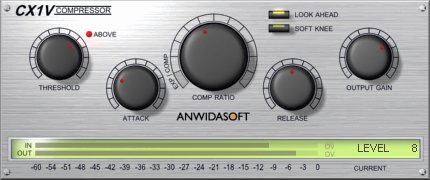|

CX1V 1.1 Compressor/Expander PC VST Plug-in
According to ANWIDA, the standards they set for the design of the CX1V are "great simplicity of use" and "extremely transparent action with a natural and smooth response." On both counts they have succeeded.
Although a small help file is provided with the compressor to explain briefly the function of each of its controls, none is really needed. In spite of its generous range of features, the CX1V is virtually self-explanatory. The simple and easily adjustable hardware-style controls include: Threshold (with an "above" indicator to show when the compressor is acting on the input signal), Attack, Compression/Expansion Ratio, Release, Output Gain, Hard or Soft Knee, and Look Ahead On or Off. There is also an input/output level VU meter which includes a display of the most recently selected parameter value. Overall, the design is very pleasing.
In addition to those features, and depending on the host, parameter automation and eight factory presets are available.
As to sound, ANWIDA delivers what it promises. Behind the interface is 64-bit internal processing, as well as support for 24-bit/96kHz audio. The sound is consistently transparent (which makes it especially suitable for use on a final mixdown), and the signal dynamic range compresses smoothly even at extreme settings. In our tests, for example, we found that the CX1V is effective in softening transients, such as from drum kits, without adding any coloration. Sometimes the transparency was so effective overall that we often checked to make sure the compressor was active (the active/bypass functions are host dependent). But the only noticeable difference between the compressed and uncompressed signal was the expected reduction in the dynamic range, and nothing more. As to the kinds of drawbacks sometimes found on other compressors, we experienced no pumping, breathing or popping under any normal settings.
Since most musicians are usually concerned with compression rather than expansion of dynamic range, it is easy to forget that the CX1V is also an expander. However, the expansion capability worked just as well and displayed the same virtues of transparency and smoothness.
There are a couple of additional points to keep in mind. We found, as others have noted, that this compressor seems to work best when it is fed a high input signal level. In addition, the demand on CPU usage is very low, which means that on most computers there should be little problem running as many instances of the CX1V as needed for multi-track recording.
In general, this uncomplicated, straightforward compressor/expander is a reliable workhorse. It does the job it's supposed to do, and it does it very well.
(See also our reviews of ANWIDA's L1V 1.1 Limiter/Maximizer and their GEQ15V 1.1 and GEQ31V 1.1 Graphic Equalizers.)
System Requirements:
- 200 MHz Pentium processor (or higher), or 100% equivalent
- At least 32MB RAM
- Windows 9x/ME/NT4/2000/XP (soon available for MAC OS)
- VST2.0 compatible audio host application
Product Pages:
Price: $69.00 USD
For more information, visit ANWIDA Soft.
Reviewed in January 2003.
Musician's Tech Central
Copyright © 1997-2024
James A. Putnam
All Rights Reserved
|